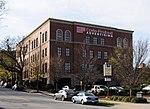South Carolina Governor's School for the Arts & Humanities
The South Carolina Governor's School for the Arts & Humanities (SCGSAH) is a prestigious boarding school for the arts located in Greenville, South Carolina, United States. Founded in 1999 by Virginia Uldrick, the high school program provides pre-professional training in creative writing, dance, drama, film, music and visual arts to sophomores, juniors and seniors, in a master-apprentice, arts-centered community. The Governor's School also offers arts-intensive summer programs for 7th-through-11th-grade students. As one of the state's two Governor's Schools, enrollment is eligible to any South Carolina student with selection based on application to individual arts areas and auditions for most programs. High school study consists of academic coursework that meets the requirements of the South Carolina high school diploma, studio practice with professional artist-faculty members, and a humanities-focused component integrated throughout the academic year. Tuition for the nine-month high school is free; financial assistance is available to offset the required purchase of a high school meal plan and a residence hall fee. As a part of its mission, the Governor's School serves as an arts resources to all teachers and students in South Carolina, offering comprehensive outreach programs designed to bring together artists, educators, community organizations and schools.
Excerpt from the Wikipedia article South Carolina Governor's School for the Arts & Humanities (License: CC BY-SA 3.0, Authors).South Carolina Governor's School for the Arts & Humanities
Furman College Way, Greenville Downtown
Geographical coordinates (GPS) Address Phone number Website External links Nearby Places Show on map
Geographical coordinates (GPS)
| Latitude | Longitude |
|---|---|
| N 34.843159 ° | E -82.401562 ° |
Address
South Carolina Governor's School for the Arts and Humanities
Furman College Way
29601 Greenville, Downtown
South Carolina, United States
Open on Google Maps










